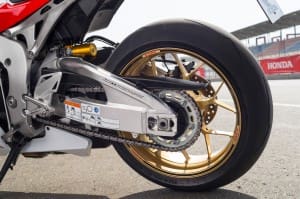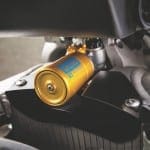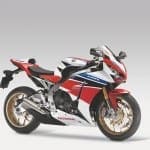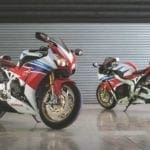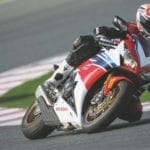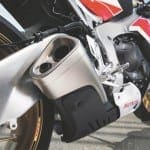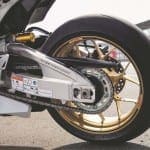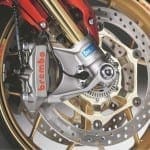£14,999 | 178bhp | 84lb-ft | liquid-cooled four cylinder
Tested by Roland Brown. Motorcycle Journalist and former international racer, Roland Brown is one of the world’s most respected bike testers. Subscribe to his fantastic YouTube channel – iMotorcycle Video – here.
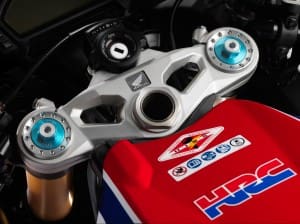 The new SP model is the most exotic, highest-specification Fireblade that Honda has produced since shaking up the super-sports world with the original CBR900RR back in 1992. Those SP initials — used on a ’Blade for the first time — traditionally stand for Sport Production, meaning a hotted-up, track ready version of the standard bike.
The new SP model is the most exotic, highest-specification Fireblade that Honda has produced since shaking up the super-sports world with the original CBR900RR back in 1992. Those SP initials — used on a ’Blade for the first time — traditionally stand for Sport Production, meaning a hotted-up, track ready version of the standard bike.
And that’s exactly what the Fireblade SP is. For 2014, the standard model is updated with a mildly tuned 999cc engine, subtly revised frame, more aggressive riding position and double-bubble screen. The SP adds to those changes with blueprinted engine internals, Öhlins suspension, Brembo Monobloc front brake calipers, new triple clamps, sticky Pirellis, single seat and lightened rear subframe.
What neither the standard nor even the SP version of the Fireblade does is follow most of its super-sports opposition by incorporating electronic features, apart from the option of ABS brakes. The SP is the trickest, most lavishly equipped and expensive Fireblade yet but in many respects it’s still fiercely traditional — an alternative to the ranks of ever more complex sports bikes.
Much of the 16-valve unit dates back six years to the Fireblade’s last complete redesign. For 2014 the standard model gets a modified cylinder head with reshaped and polished inlet and exhaust ports, plus gas-flowed combustion chambers. The intake trumpets are reshaped with slash-cut tops, as developed in World Superbike.
The Fireblade’s injection system is revised to suit, but there’s no sign of ride-by-wire or alternative engine modes, let alone traction control. Maximum power is increased by 2bhp to 178bhp at 12,250rpm. Compared to the previous model there’s a small improvement between 4-6000rpm and above 10,000rpm, and a similarly slight reduction between 7-9000rpm.
The SP also gets blueprinted internals. Basically each piston’s maximum weight variation from the target 177g is one gram, rather than the normal three. The main benefit is reduced vibration. This is difficult to notice in isolation but Ron Haslam, whose racing school uses Fireblades, thought the SP felt notably smoother.
Pretty fancy. Honda’s first ever use of Öhlins suspension is the stand-out feature, and there’s far more to the SP than simply a Fireblade with some bolt-on extras. The Swedish firm’s engineers worked with Honda to develop the chassis, which also incorporates new, stiffer triple clamps and an aluminium twin-spar frame that was revised around the swing-arm pivot to make it less rigid, for improved feel.
This mod was also incorporated into the standard model. So was the revised riding position, which angles the clip-on bars slightly wider and lower, and moves the footrests back by 10mm. Only the SP gets sticky Pirelli SuperCorsa SP tyres, and a single seat. The latter allows the rear subframe to be lightened, saving a kilogram and bringing wet weight to 199kg (or 210kg with ABS).
The SP also uses Brembo’s Monobloc calipers in place of the standard model’s radial Tokicos, and Honda’s development didn’t stop there. The C-ABS linked anti-lock system is updated, now giving less front brake when the rear pedal is used, and none at all when it’s used very gently. Initial activation of the front brake is also smoother.
If you’re a Fireblade fan and can afford the considerable price of £14,999, or better still an extra £600 for the C-ABS equipped version, then why not? These days the shrinking super-sports market seems to be polarising into two groups, with most manufacturers putting their development effort into hugely powerful bikes with high-tech electronics aimed at helping the rider keep it all under control.
But some riders prefer the traditional method of development, aimed at creating high but not excessive horsepower with the emphasis on the way it’s delivered, and a chassis whose main aim is to help the rider use brain and right wrist, not electronics, to go fast. The Fireblade has long been the leader of this group — generally scoring well in comparison tests despite a relatively Stone-Age specification — and the SP takes Honda’s approach to a new level.
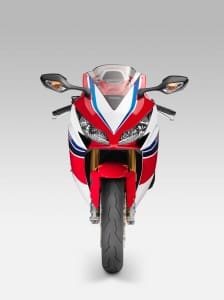 There’s no doubt that the best modern traction control systems work very well, and there’s a strong argument that most riders could lap quicker and in more safety with an electronic safety net. But equally the SP’s controllability and chassis quality mean it’s very fast and rewarding to ride.
There’s no doubt that the best modern traction control systems work very well, and there’s a strong argument that most riders could lap quicker and in more safety with an electronic safety net. But equally the SP’s controllability and chassis quality mean it’s very fast and rewarding to ride.
The Fireblade SP might lose the Top Trumps battle over maximum horsepower or electronic gizmos, but with Öhlins, Brembo and Pirelli as well as its blueprinted engine (and a classy, HRC-inspired paint job) it has plenty of glitz. And if the Fireblade’s World Superbike showing has been disappointing of late, Honda fans can point to Alex Lowes’ BSB title, Suzuka 8-Hour wins by teams starring Johnny Rea and Leon Haslam, and the TT triumphs of John McGuinness and Michael Dunlop.
So what’s it like to ride?
Like the previous Fireblade — but a little bit tauter, racier and quicker. You’re never going to notice an extra two horsepower but on its launch at the Losail track in Qatar the Fireblade felt strong through the midrange, fuelling very crisply, and pulling sweetly once into its stride at 6000rpm.
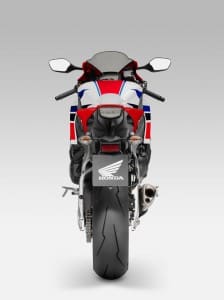 There was no noticeable dip even if it is slightly less torquey than the old model through the midrange, before coming on stronger between 10,000rpm and the rev limit at 13,000rpm. A couple of riders found the unchanged gearbox slightly notchy but I didn’t have any problems with it, though it’s a shame that a bike of this quality and price doesn’t come with a quick-shifter.
There was no noticeable dip even if it is slightly less torquey than the old model through the midrange, before coming on stronger between 10,000rpm and the rev limit at 13,000rpm. A couple of riders found the unchanged gearbox slightly notchy but I didn’t have any problems with it, though it’s a shame that a bike of this quality and price doesn’t come with a quick-shifter.
Any aerodynamic advantage from the double-bubble screen would have been magnified on the circuit’s long main straight by the raging headwind, which tried to push me off the back of the bike after I’d sat up to brake at just over 160mph and counting. Otherwise I didn’t notice the slightly more aggressive ergonomics, though I did still find the riding position slightly cramped for my long legs. (Adjustable pegs would be nice…)
Handling was exceptional, notably from that Öhlins front end, whose solid, confidence-inspiring feel was remarkable even by the high standards of modern super-sports bikes. The rear TTX36 shock also gave a superbly well controlled ride, after a few clicks of preload and compression damping had been added to the stock track settings. Honda’s work with Öhlins also involved relocating the adjusters for easier access, but you’ll have to pay extra for a ride-height adjuster.
 Braking power from the specially developed Brembo Monoblocs was fierce, with the C-ABS system doing a good job. Honda’s system gives slightly different feel to a conventional ABS set-up, but the bottom line is you can stop hard in safety. It also adds a dab of rear anchor, which can be useful, though there’s a weight penalty of 11kg. If you can ride like Leon Haslam, whose tyre-smoking corner exits showed no need for traction control, you’ll doubtless brake slightly harder without ABS. Most normal riders are probably better off with it. The crash rate at dad Ron’s racing school halved after they started using ABS-equipped Blades.
Braking power from the specially developed Brembo Monoblocs was fierce, with the C-ABS system doing a good job. Honda’s system gives slightly different feel to a conventional ABS set-up, but the bottom line is you can stop hard in safety. It also adds a dab of rear anchor, which can be useful, though there’s a weight penalty of 11kg. If you can ride like Leon Haslam, whose tyre-smoking corner exits showed no need for traction control, you’ll doubtless brake slightly harder without ABS. Most normal riders are probably better off with it. The crash rate at dad Ron’s racing school halved after they started using ABS-equipped Blades.
Pirelli’s SuperCorsa SPs grip well and are a good track-day choice, though embarrassingly I proved they’re not infallible by crashing on the first lap of my second session, having not realised that the strong wind had cooled the front tyre while the bikes were being refuelled. I should have known better than to set off behind Honda WSB rider Johnny Rea even when he was trying to ride slowly… The afternoon sessions were on super-sticky SuperCorsa SC race rubber that gave an even more planted feel.
The SP is definitely the ultimate Fireblade. It’s fast, refined and sweet handling; very well equipped in some areas, although less so in others. Whether it’s the ultimate Sport Production machine depends on what you want and expect from a cutting-edge superbike.
Tested by: Roland Brown Photos by: Zep Gori, Francesc Montero and Ula Serra
TECH SPEC
Honda Fireblade SP (2014)
Price: £14,999
Engine: Liquid-cooled dohc four with four valves per cylinder
Power: 178bhp (133kW) @ 12,250rpm
Torque: 84lb-ft (114Nm) @ 10,500rpm
Curb weight: 199kg (210kg with C-ABS)
Seat height: 820mm
Tank size: 217.5 litres




